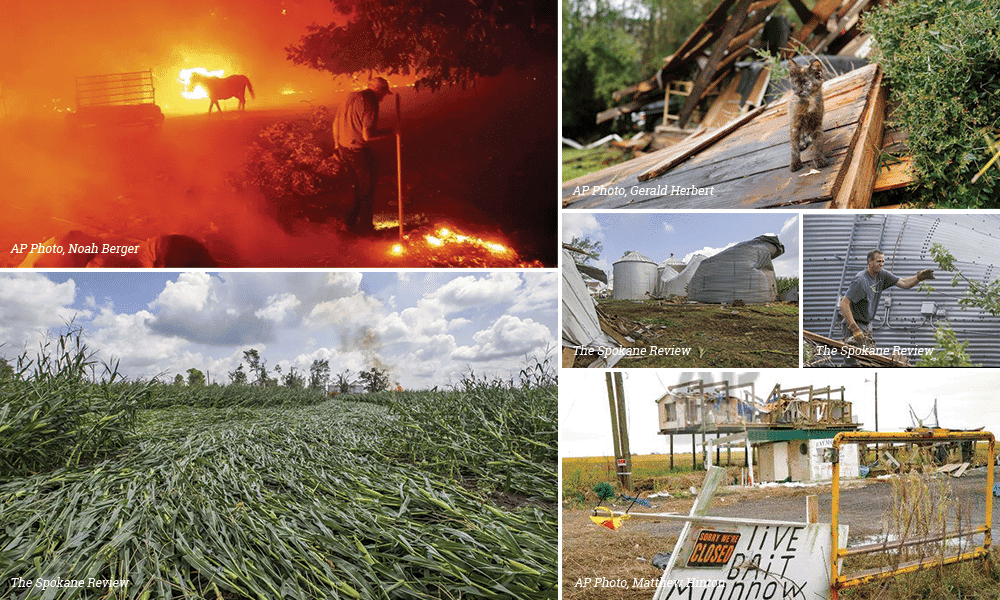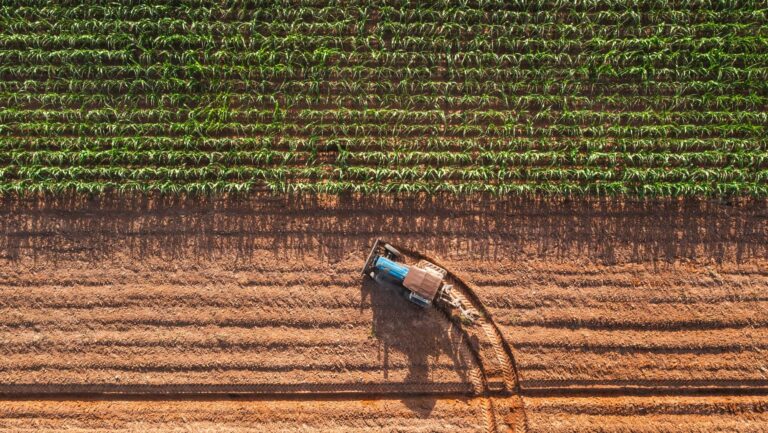2020 Year in Review: Top Five Events for U.S. Agriculture
Looking back on the trials and triumphs of 2020.
The start of this decade has been an eventful one, abundant with unforeseen moments unlike anything we’ve experienced together as a nation before—a global pandemic combined with an abnormal amount of severe weather events and topped off with an influential presidential election that will set us up for the road ahead in 2021.
With the dawn of a new year comes a time of reflection on the events that shaped us throughout the past 12 months. While hard to narrow down, five events stuck out as the most influential moments for U.S. agriculture in 2020.
- COVID-19 Impact on U.S. Agriculture;
- An Influx of Natural Disasters;
- A Year of Volatility for Global Trade;
- A Pivotal Presidential Election; and
- The Rise of Agricultural Awareness.
1. The COVID-19 Pandemic Impact on U.S. Agriculture
Even at the height of business closures and uncertainty, American farm operations never stopped running—but not without adversity, as pointed out in a Global Ag Network episode that aired earlier in the year with AgAmerica’s CEO, Brian Philpot.
Listen to the full episode here.
Instead, American farmers across the nation pivoted and adapted to meet the needs of consumers. AgAmerica followed suit, leaning into the incoming challenges and looming uncertainty. We reached out to existing clients while staying fully operational for new ones to provide the flexible financing needed to weather the storm. The Chief Economist of AgAmerica, Dr. John Penson, closely monitored the economic climate and provided some clarity in the chaos regarding its direct and potential impacts on U.S. agriculture.

Key insights from AgAmerica’s economic assessments of COVID-19’s impacts on U.S. agriculture:
- An estimated $1.5 trillion loss in economic output was purported in the first quarter of the year, during the first peak of the pandemic.
- The unemployment rate started the year at 3.6 percent, peaked at 14.7 percent in April, and fell to 6.7 percent by the end of November.
- The federal budget deficit reached $3 trillion as of June 2020.
- Poultry, pork, beef, and dairy sectors experienced the sharpest decline in commodity futures, ranging from 28.3 to 48.4 percent.
- Net cash farm income is forecast to increase 22.6 percent to $134.1 billion, due mostly to federal subsidies and crop insurance payments.
- The substantial fiscal response of the government made up an estimated 36 percent of net farm income in 2020.
- The 2020 farm bankruptcy rate of 2.56 percent remains below the 2010 high of 3.76 percent.
2. An Influx of Natural Disasters
As if the emergence of a pandemic wasn’t enough, American farmers faced unrelenting weather events from East Coast hurricane season to West Coast wildfires.
How did severe weather events in 2020 impact U.S. agriculture?
- In 2020, crop insurance indemnity payments increased 66 percent.
- Nearly 38 million acres of farmland were impacted by the Midwest derecho in August.
- Recorded global natural disaster events increased more than 43 percent in the past two decades compared to two decades prior.
- Acreage burned from California wildfires in 2020 increased 94 percent compared to acreage burned in 2019, totaling over four million acres.
- This year generated 30 named storms, the most on record, including 13 hurricanes.
These unpredictable weather events contribute to the volatility of the industry as their impacts can reverberate through the industry and create lasting effects on the farmers who keep us fed. In 2018, a multi-generational farmer in Georgia allowed us to document and share his experience facing Hurricane Michael, which led to the destruction of his century-old pecan trees. His journey is like all too many experiences felt by farmers across the country this year, as they watched the fate of their hard work rest in the hands of the forces of nature.
3. A Year of Volatility for Global Trade
The passing of the Phase One trade deal marked China’s promise to buy $200 billion of U.S. goods by the end of 2021—including more than $36.5 billion of U.S. agricultural products by the end of 2020. Yet what began as a stance against the trade deficit between the two economic powerhouses, soon turned into an even more complex issue when COVID-19 quickly spread throughout all corners of the world and created doubt as to whether China would be able to uphold what was considered to be an already aggressive goal prior to the pandemic. In a joint statement, the U.S. Trade Representative’s office and the U.S. Department of Agriculture reported that China had bought over $23 billion in U.S. agricultural goods by the end of October, or about 71 percent of the target set under the Phase One deal.
The total sum of U.S. agricultural exports to China reported in 2020:
- Corn: Outstanding sales of U.S. corn to China are at an all-time high of 8.7 million tons.
- Soybeans: U.S. soybeans sales for the marketing year 2021 are off to the strongest start in history, with outstanding sales to China double 2017 levels.
- Sorghum: U.S. exports of sorghum to China from January to August 2020 totaled $617 million, up from $561 million for the same period in 2017.
- Pork: U.S. pork exports to China hit an all-time record in the first five months of 2020.
- Beef: U.S. beef and beef products exports to China through August 2020 were more than triple the total for 2017.
In addition to these products, the USDA projected record and near-record sales to China in 2020 for other U.S. agricultural products as well, including pet food, alfalfa hay, pecans, peanuts, and prepared foods.
However, as the uncertainty in trade with China unfolded, numerous global trade agreements were either in the works or at a stalemate throughout the course of the year.
4. A Pivotal Presidential Election
In the midst of a pandemic, 2020 marked the year of a memorable presidential election. The results of this election will be a key contributing factor in agricultural legislation in the coming year and also the development of the 2023 Farm Bill. During the election, AgAmerica laid out the public stances of both administrations.
Find out which direction the future of agricultural legislative reform will likely take and the major initiatives that will fuel ag policy in 2021.
5. The Rise of Agricultural Awareness
Agricultural awareness began brewing at the start of 2020 as more consumers expressed an interest in their food source and more companies began picking up on this trend. Marketing campaigns, such as the “6 for 6-Pack” initiative by Michelob Ultra to introduce their new product brewed from organic wheat, began to take shape and consumers leaned into voting with their dollar.
Then COVID-19 emerged on national shores and propelled the importance of a resilient, domestic food chain to the front and center of the public eye. The perseverance and dedication of farmers across the country to keep our nation sustained in the face of unprecedented obstacles was noticed and reflected in the consumer attitudes reported in an American Farm Bureau Federation survey conducted this year:
- Nine out of ten adults report having “some” or “a lot of” trust in farmers.
- Four out of five adults describe the accomplishments of farmers through conservation programs as “good” or “excellent”.
- More than three in five adults believe corporations should compensate farmers for the additional costs of implementing environmentally sustainable practices.
- More than three-quarters of adults believe the government should fund rural infrastructure improvements.
At AgAmerica, we shifted our major 2020 initiatives to meet farmers and ranchers in their efforts and have never been more proud to be a part of such an essential industry rich with honorable and altruistic character.
Looking Ahead to the State of U.S. Agriculture in 2021
The challenges of 2020 created defining moments for U.S. agriculture. Through these moments, American farmers and ranchers established their perseverance and resilience as they always do but this time—with processing plant closures and logistical bottlenecks threatening supply availability in grocery stores—the general public was paying attention. The renewed appreciation for the fundamental role of American farmers and ranchers in our society led to historic federal support and growth in direct-to-consumer business models. Farmers’ markets were deemed essential and consumers expressed increased interest in buying directly from their local farm operations.
As we move forward into a new chapter for the agricultural community, more than 44 percent of farmers expressed positivity towards the farm economy and more than 61 percent are optimistic about the state of their financial health in 2021. In the spirit of the AgAmerica mission—to help farmers thrive in the good times and sleep well in the tough ones—we will continue devoting our time, energy, and resources to champion the American Farmer in an evolving world. With a singular focus on agricultural land finance, we are able to support the important work of farm operations nationwide with flexible loan structures that are customized to their unique operational needs.
Contact us today if you want to start the year with a firm financial structure and learn more about what it means to partner with a lender who supports and advocates for a thriving future for American farms across the nation.














